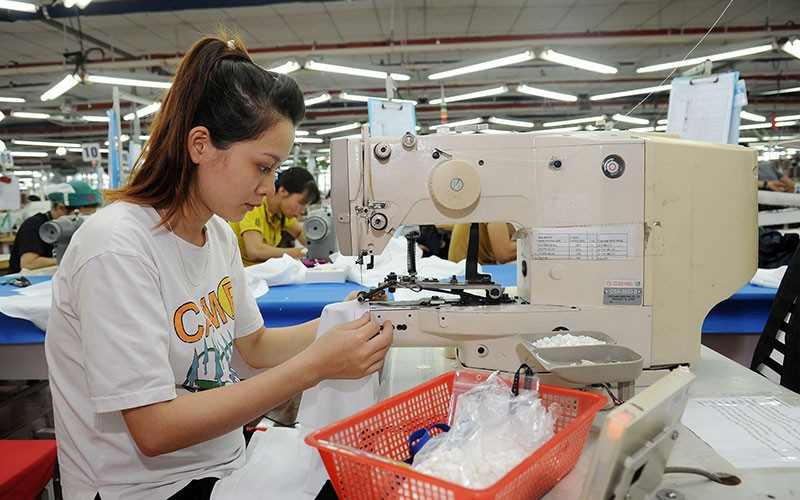According to the Ministry of Industry and Trade, the US is still the largest export market of Vietnam. However, in the first seven months of this year, export turnover to this market decreased sharply at an estimated 52.4 billion USD, down nearly 22% compared to the same period last year. Fortunately, in recent time, there have been positive signs that this market is begining to "warm" gradually.
The again increase of orders
For Vietnam's textile and garment industry, the US has always been a key market that have been continuously accounting for more than 40% of the export proportion of the whole industry in recent years. Truong Van Cam, Vice Chairman of the Vietnam Textile and Apparel Association (VITAS), said Vietnam's textile and garment export turnover to the US market was second only to China in 2022, reaching 17.8 billion USD. This is a very impressive number. The first months of the year are very difficult for textile and garment exports in all markets. Regarding the US specifically, the export turnover of textiles and garments in the first six months was just over 6 billion USD, down about 27% from the same period last year.
The US is also a large market for Vietnam's wood industry, usually accounting for about 50-55% of the total export value of the whole industry. In 2022, the export turnover of wood and wood products to the US reached about 8.3 billion USD. However, since the beginning of the year, wood exports to this market have a seen a continuous sharp decrease. According to Vice President and General Secretary of the Vietnam Timber and Forest Products Association (VIFORES) Ngo Sy Hoai, in addition to the general difficulties, there is also a reason that the US real estate industry is in a period of slowing down. The total value of imported wood products of this country decreased by more than 50%.
Fortunately, there have been optimistic signs for wood exports to the US. Specifically, the wood industry's export turnover to the US in June reached 638 million USD, a year-on-year decrease of only 18.4%. It is expected that Vietnam will regain the momentum of export growth at the end of the year as the US market gradually recovers and "warms", because Vietnamese wood products have partly affirmed their position in this market and Vietnamese wood enterprises have also clearly shown their bravery and competitiveness. “Despite the immediate difficulties, we assess they are only temporary. In the long run, it is difficult for the US to find a supplier of wood products to replace Vietnam in terms of quality and price,” said Hoai.
Chairman of the Board of Directors cum General Director of Duc Thanh Wood Joint Stock Company Le Hai Lieu said as a business with great experience in exports to the US, all of Duc Thanh’s main products such as wooden furniture, toys, tables, chairs, beds, and cabinets are already present in this market. After the recent difficult period, there have been US customers recently returning to order Duc Thanh, even announcing the number of orders in the future. The number of orders in the previous period decreased mainly due to difficulties from the general economy and tight spending. When the situation stabilises again, the demand of the US market is still very large.
Taking advantage of opportunities
According to the Department of European-American Market under the Ministry of Industry and Trade, Vietnam has been transforming strongly in recent years towards becoming a major global production centre. Vietnam has a wide variety of products with competitive prices and improved quality. In addition, following the pandemic as well as the recent geopolitical-economic uncertainties, many corporations and retail and wholesale distribution channels have been boosting their diversification strategies and ensuring sustainable supply, and have chosen Vietnam as one of their strategic locations in their global supply chain.
However, in the context of the current global economic difficulties, consumption trends in export markets of Vietnam in general and the US in particular are assessed to change. This requires Vietnamese businesses to adapt to those changes. Tran Minh Thang, Head of the Vietnam Trade Office’s Branch in San Francisco, the US, said that the US has demand for goods from Vietnam, but this is also a market that receives a lot of offers from businesses around the world. Therefore, Vietnamese businesses need to persevere in accessing and introducing products.
Furthermore, businesses must also actively participate in trade promotion programmes, exhibitions and fairs and connection with relevant agencies, creating prestige and trust with US customers. Head of the Vietnam Trade Office’s Branch in Houston (the US), Do Manh Quyen, recommended that Vietnamese enterprises need to redefine their production and business strategies and plans, clearly define markets and products, carefully study regulations and barriers for exports to large markets such as the US, and continuously improve their quality and production technology.
To develop the market, in addition to cooperating with large distribution channels, businesses also need to find niche markets, because large distributors will disconnect when the demand decreases, causing disruption for the export activities of enterprises. When promoting trade, businesses should look to local partners to sign consulting contracts to find niche markets and handle inventory and retail goods.
The Ministry of Industry and Trade is continuing to find ways to remove difficulties and obstacles of Vietnam's export businesses and associations, and more effectively support enterprises to join the global production and supply chain, promote the connection between distribution channels, foreign importers, and domestic manufacturing enterprises. On the other hand, overseas Vietnamese trade offices are also promoting guidance on policies of regions and markets, including the US, to help Vietnamese businesses get more information to make better use of the opportunities for market penetration.
The ministry will also open many forums in the near future to provide information about the market as well as offer different strategies to remove difficulties for businesses and improve the competitiveness of Vietnamese goods in the foreign markets.
















